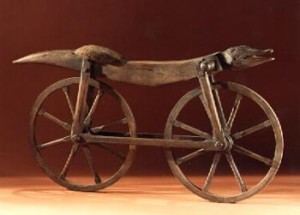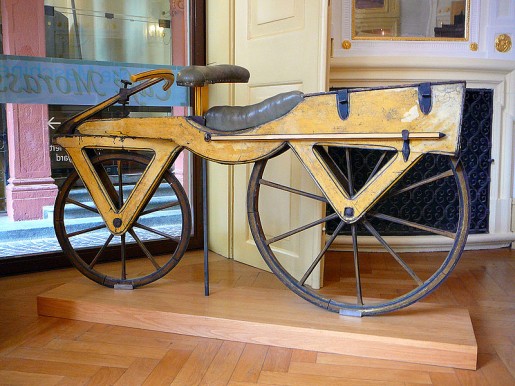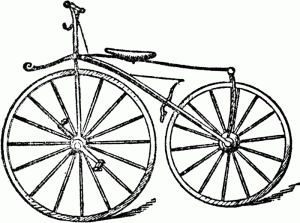I’d like to start off this post with one of my favorite quotes about the bicycle from a Baltimore minister in 1896:
“[It is] a diabolical device of the demon of darkness … imbued with a wild and satanic nature.”
Whoa! Talk about a rough start. But that is the how the bike began. With criticism like this, it’s amazing that the bike even survived to modern times.
The bicycle has been rolling along now for nearly 200 years. It has undergone multiple transformations, endured harsh criticism and even changed the face of fashion. This seemingly simple machine inspired automobiles, plane designs and modern roads. It helped the campaign for women’s rights, expanded people’s worlds, and, today, it is enjoyed across the world over as a way to exercise, commute or just enjoy a nice day.
And now, ladies and gentlemen, in honor of Bike to Work Day, I present to you: the history of the bicycle!
Rolling through history
Imagine a bike made entirely out of wood: no means of steering, no brakes, no pedals and an animal head in front. That’s what the first versions of the bike looked like. Mede de Sivrac invented a two-wheeled device in 1790 that was basically a rocking horse with wheels. Although the origins of the bike are disputed, historians consider this invention an inspiration to the modern bicycle.
In 1817, Karl von Drais replaced the head with steering bars and a less bulky design. Although primitive, the steering capabilities sent this version into further development. This slight alteration earned von Drais the title “Father of the Bicycle”, even though the invention was impractical for long-distance travel. Not to mention, it scared the locals. According to Riding High: The Story of the Bicycle by Arthur Palmer, adults and town leaders thought von Drais’ contraption was dangerous and threatened to expel him from the streets if he didn’t give up his crazy ideas.
Von Drais’ bike mainly was used for downhill riding and involved a lot of awkward pushing and coasting. Kirkpatrick Macmillan, a blacksmith from Scotland, didn’t find this propulsion method practical. In 1838, he added pedals to the frame, which allowed riders to propel themselves without touching the ground. This version was the first practical bicycle.
After the addition of pedals, the bike went through a long period of awkward change. Just like a teenager going through puberty, the bicycle spent many years growing into itself. Some versions experimented with wheel size. Others became giant tricycles, and another version had side seats for women to ride in. By the mid-1800s, the bike was gaining popularity, but it needed improvements. Wooden frames and iron tires gave it the nickname “boneshaker.” It also drew criticism as a danger and a nuisance. With the addition of air-filled rubber tires in 1888, the bike became safer, quieter and more comfortable.
As the bike changed, so did society. Police officers, postmen, milkmen and the military began using bikes to perform their jobs in the late 19th century. A makeshift ambulance was even made by attaching a stretcher between two bikes. Not surprisingly, the ride turned out to be unsafe for the patient and the method didn’t catch on. In 1880, the League of American Wheelmen was formed. The league successfully lobbied for paved roads to make them more accessible, safe and passable for bikers no matter the weather. These improvements smoothed the way for the future automobiles.
In the 1890s, bikes were being mass-produced, making the once expensive plaything of the wealthy affordable for the average worker. “It would not be at all strange if history came to the conclusion that the perfection of the bicycle was the greatest incident in the nineteenth century,” wrote the Detroit Tribune in 1896. Just as today’s society marvels at the advancement of technology, those of this era were experiencing similar changes and excitement as they discovered new horizons on their bikes.
Perhaps one of the most important historical contributions of the bicycle was its place in the women’s suffrage movement. At first, women were not allowed to ride bikes at all. Special seats were made for them on men’s bikes. Eventually, bicycle manufacturers and advertisers realized the amount of money that could be made among the female market – and so women began riding their own bikes.
Critics believed bike were bad for women’s health, morals and fertility. Some physicians thought cycling could damage a women’s reproductive system, but it was the change in female fashion that caused the most uproar.
Dresses of the 19th century included yards of fabric for long, full skirts and corsets made of bone and metal to accentuate the torso. Not exactly proper exercise attire. Skirts started to rise, and jaws started to drop. In fact, the bicycle was the catalyst that introduced pants to women. Amelia Bloomer invented pants that were loose in the leg and tight around the ankle, called them “bloomers” and forever changed the face of fashion.
Susan B. Anthony said the bike had done more to emancipate women than anything else in the world. “What years of eloquent preaching from the platform of women’s suffrage have failed to accomplish, the necessities of this wheel have in a few months brought into practical use,” said Mrs. Reginal de Koven in 1896’s Bicycling for Women.
The 1890s were truly the “Golden Age of the Bicycle.” Prices were going down due to mass production. Between 1890 and 1900, the bike industry increased from 27 manufacturers to more than 300. In 1896, which was the peak of the craze, it was estimated there were more than three million bicycles in the U.S.
But soon the bike went into the ring with its biggest contender, the automobile, and never recovered from the hit. When two bike mechanics named J. Frank and Charles E. Duryea became the first commercial car manufacturers in America in 1893, things began to change for the bike. It wasn’t until 1908 when Henry Ford introduced assembly line production and his Model T that the automobile replaced the bike for transportation.
Nineteenth century cycling advocate Maria E. Ward said, “The bicycle (was) an educational factor … creating the desire for progress, the preference for what is better, the striving for the best, broadening the intelligence and intensifying love of home and country.” Bicycles sparked people’s interest in speed and expansion. Besides its contributions to paved roads and automobiles, the bike helped improve metals, manufacturing and engineering. In fact, two famous bicycle shop owners, Orville and Wilbur Wright, used the principles of bike construction — strong, light and simple — in the design of their aircraft.





No Comments